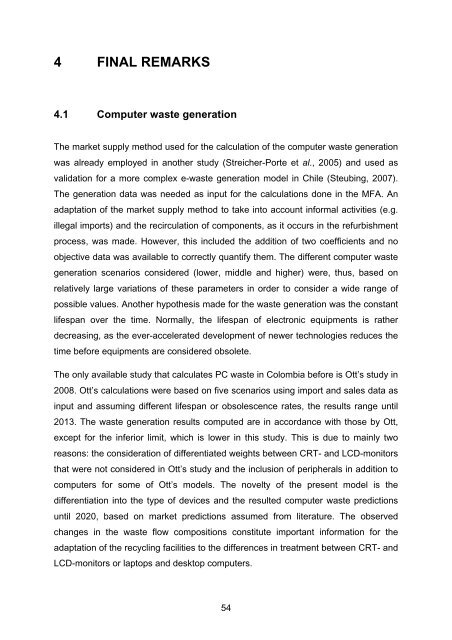10 07 29 Master thesis Juliana Leon - e-Waste. This guide
10 07 29 Master thesis Juliana Leon - e-Waste. This guide
10 07 29 Master thesis Juliana Leon - e-Waste. This guide
Create successful ePaper yourself
Turn your PDF publications into a flip-book with our unique Google optimized e-Paper software.
4 FINAL REMARKS<br />
4.1 Computer waste generation<br />
The market supply method used for the calculation of the computer waste generation<br />
was already employed in another study (Streicher-Porte et al., 2005) and used as<br />
validation for a more complex e-waste generation model in Chile (Steubing, 20<strong>07</strong>).<br />
The generation data was needed as input for the calculations done in the MFA. An<br />
adaptation of the market supply method to take into account informal activities (e.g.<br />
illegal imports) and the recirculation of components, as it occurs in the refurbishment<br />
process, was made. However, this included the addition of two coefficients and no<br />
objective data was available to correctly quantify them. The different computer waste<br />
generation scenarios considered (lower, middle and higher) were, thus, based on<br />
relatively large variations of these parameters in order to consider a wide range of<br />
possible values. Another hypo<strong>thesis</strong> made for the waste generation was the constant<br />
lifespan over the time. Normally, the lifespan of electronic equipments is rather<br />
decreasing, as the ever-accelerated development of newer technologies reduces the<br />
time before equipments are considered obsolete.<br />
The only available study that calculates PC waste in Colombia before is Ott’s study in<br />
2008. Ott’s calculations were based on five scenarios using import and sales data as<br />
input and assuming different lifespan or obsolescence rates, the results range until<br />
2013. The waste generation results computed are in accordance with those by Ott,<br />
except for the inferior limit, which is lower in this study. <strong>This</strong> is due to mainly two<br />
reasons: the consideration of differentiated weights between CRT- and LCD-monitors<br />
that were not considered in Ott’s study and the inclusion of peripherals in addition to<br />
computers for some of Ott’s models. The novelty of the present model is the<br />
differentiation into the type of devices and the resulted computer waste predictions<br />
until 2020, based on market predictions assumed from literature. The observed<br />
changes in the waste flow compositions constitute important information for the<br />
adaptation of the recycling facilities to the differences in treatment between CRT- and<br />
LCD-monitors or laptops and desktop computers.<br />
54
















